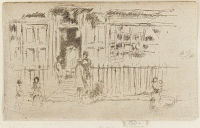Etchings Institutions search term: grolier club
Little Steps, Chelsea | ||
| Number: | 269 | |
| Date: | 1886 | |
| Medium: | etching | |
| Size: | 51 x 86 mm | |
| Signed: | butterfly at right | |
| Inscribed: | no | |
| Set/Publication: | no | |
| No. of States: | 2 | |
| Known impressions: | 5 | |
| Catalogues: | K.262; M.258; W.213 | |
| Impressions taken from this plate (5) | ||
KEYWORD
TITLE
'The Steps' (1886, Frederick Wedmore (1844-1921)). 2
'The Steps' (1887/1888, Whistler). 3
'The Steps Millmans Row' (1890/1891, Whistler). 4
Possibly 'Steps. The - Justice Walk' (1890/1892, Beatrice Whistler (1857-1896)). 5
'Lawrence St. Chelsea' (1903/1935, possibly Rosalind Birnie Philip (1873-1958)). 6
''The Steps, Chelsea' (1909, Howard Mansfield (1849-1938)). 7
'Little Steps, Chelsea' (1910, Edward Guthrie Kennedy (1849-1932)). 8
Kennedy wrote: 'This title ["Little Steps, Chelsea"] was given by Whistler in a list of plates cancelled'. However, no such list has been found. In the list of plates in Whistler's studio stock-taking there is one 'The Steps [tick] 3 1/4 x 2' which is presumed to be this etching. Thus the title, 'The Steps', which was also given by Wedmore, has been accepted.
The conflicting information on the sites - Millman's Row, Justice Walk or Lawrence Street - makes it impossible to add that information in the title.
2: Wedmore 1886 A (cat. no. 213).
3: List, [August 1887/1888], GUW #13233.
4: List, [1890/1891], GUW #13236.
5: List, [1890/1892], GUW #12715.
6: Envelope containing copper plate, Hunterian Art Gallery.
7: Mansfield 1909 (cat. no. 258).
8: Kennedy 1910 (cat. no. 262).
DESCRIPTION
SITE
9: Robins 2007 , pp. 131, 133.
